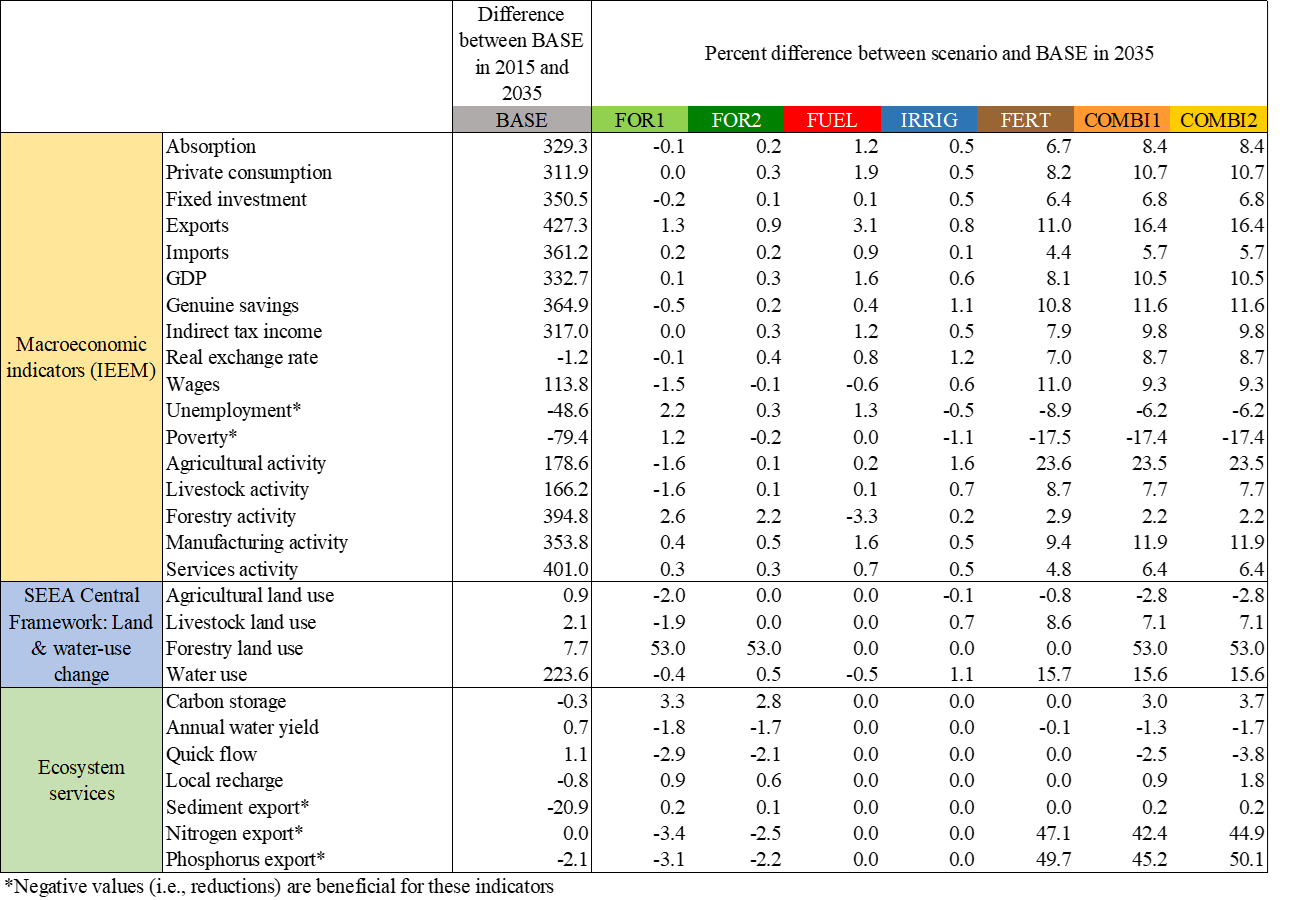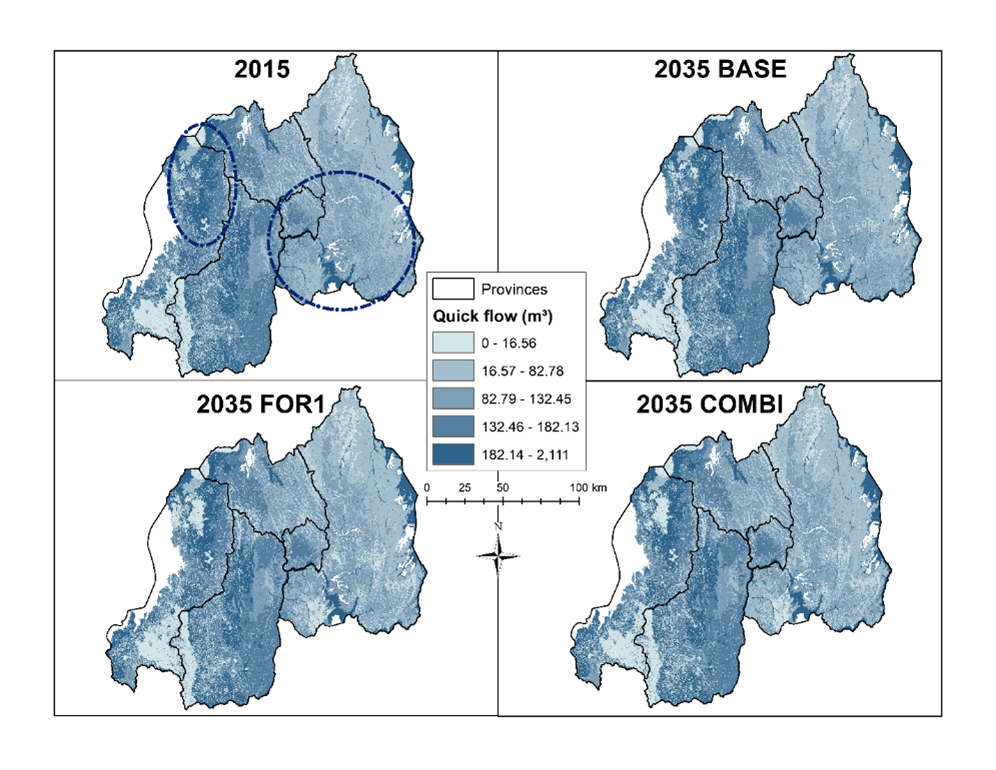Information
- Policy Theme: Green Growth
- Country: Rwanda
- Project date: August, 2017
- Project URL: Access the full paper here
Overview
Rwanda has made remarkable progress in reducing poverty and enhancing economic growth in the last 15 years. At the same time, the country faces intense pressure on its natural capital base and ecosystem services, already with the highest population density in Africa, which is projected to double by 2050. We apply the IEEM+ESM approach to understand the economic, social and environmental impacts of green growth strategies which aim to maintain natural capital while enhancing the country’s economic growth prospects.
We apply the simplified IEEM+ESM workflow described in the figure below which begins with developing and implementing scenarios in IEEM to reflect various dimensions of green growth in this case. IEEM is run for the entire analytical period providing estimates of GDP, employment, income, poverty, and wealth. IEEM also generates a projection of land use land cover change which we attribute spatially with the Dyna-CLUE land use land cover change model. The final step of the analysis involves calculating differences in ecosystem service supply in the final year with respect to the baseline projection for that same year.

The ecosystem service analysis focuses on climate change mitigation through carbon storage, water provisioning services quantified as annual water yield, quick flow and local recharge, erosion mitigation in terms of sediment retention and export, and water quality and soil fertility maintenance quantified as nitrogen and phosphorus load, export, and retention.
Scenarios and Results
We implement a baseline projection of the economy and 4 scenarios for the analytical period 2020 to 2035. The baseline (BASE) scenario projects the economy to 2035 based on projections of GDP and population and represents the reference scenario to which all other scenarios are compared. The first scenario is FOR1 which implements 110,400 ha of forest plantations where competition between land uses exist. FOR2 implements the same increase in forest plantations but without competition between land uses. The FUEL scenario simulates the use of more efficient household cookstoves and charcoal kilns. IRRIG converts 85,473 ha of rainfed farmland to irrigated farmland. With Rwanda exhibiting one of the lowest rates of fertilization globally, FERT simulates an increase in fertilization to reach 45 kg/ha/yr or a 57% increase in fertilizer use overall. COMBI1 is the joint implementation of FOR1, FUEL, IRRIG and FERT, and accounts for urban expansion. COMBI2 is the same as COMBI1 except that it does not account for urban expansion.
Table 1 presents impacts by scenario on macroeconomic, System of Environmental-Economic Accounting (SEEA) Central Framework, and ecosystem services indicators.

These results show that the FERT scenario would have the greatest positive impact on GDP and genuine savings, a metric of wealth, as well as in reducing unemployment and poverty. The joint implementation of all scenarios (COMBI1 and COMBI2) would result in the greatest positive outcomes across most economic indicators. This portfolio of green growth policies would also tend to reduce agricultural land use while increasing livestock and forestry land uses. Water consumption would fall slightly only in FOR1 and FUEL but would increase in all other scenarios. In terms of ecosystem services provision, carbon storage would increase while water yield would decline; a reduction in water yield in the context of these scenarios implies an increase in water regulation services which is considered positive. With an increase in livestock land uses as well as with fertilization, there would be some rade-offs with a small increase in erosion and nutrient exports.
Figures 1 and 2 show how carbon storage and water quick flow, respectively, would change between 2015 and 2035 in the BASE, FOR1, and COMBI scenarios. The dashed circles on the maps indicate areas that experience the greatest change in the scenarios, which are in the northwest and south-central regions of the country.


Policy Insights
Considering the portfolio of green growth strategies, results show strong positive effects on the economy which would result in GDP gains of US$3,591 million and a US$763 million increase in wealth.
The ecosystem service impacts of this policy portfolio however would be mixed with increased carbon storage and local recharge, reflecting the contributions of additional forest plantations, but also increases in nitrogen and phosphorus export (42% and 45%, respectively), along with substantially greater water use (7.2 million m3/yr).
The increases in nutrient inputs to Rwanda’s surface waters would be an important issue to address since localized problems already exist with water quality and availability, particularly in the dry season. Increases in nutrient inputs of over 40% would likely make these problems more pervasive. Increasing water demand may further exacerbate water-quality problems by reducing streamflow that dilutes concentrations of nutrients and other water pollutants. Water demand and water quality related to food production are thus the two most notable ecosystem service trade-offs that emerge from our analysis. Better water-quality outcomes may be possible if forest planting can be targeted to intercept sediment and nutrients before they reach major waterways. A COMBI-type outcome that produces both positive economic and ecosystem service outcomes may be possible with planting of riparian buffers, for example. Achieving these multiple benefits may require a payment for ecosystem services-like incentive system or changes in legislation making riparian buffers an integral part of managed land-based systems. Economic arguments generated with the IEEM such as those presented here can provide the basis for the development of such measures.
Our analysis shows clear trade-offs and synergies when considering multiple strategies for achieving green growth. Many of these would have gone undetected through the conventional application of stand-alone economic, land use land cover change, or ecosystem service analysis. An economic model alone, for example, would not show the land-use or ecosystem services implications of a policy, nor would a stand-alone ecosystem service model illustrate the macroeconomic consequences and economic feasibility of policy alternatives. We show for example that increasing fertilization would have very strong positive economic impacts for Rwanda; however, the associated stress on water resources (use and quality) would increase markedly. Increased nutrient export would have diverse consequences for water quality, potential eutrophication of watercourses, and undesirable impacts to downstream water users.
On the other hand, our analysis shows that expanding forest cover has the potential to mitigate some of the water quality impacts while reducing soil erosion and providing nutrient uptake. We thus provide strong economic and environmental arguments for a portfolio approach to achieving green growth targets where fertilization, irrigation, and improving fuelwood use efficiency through forest plantations can deliver important economic benefits. Forest cover expansion provides fuelwood and other raw material, reduces nutrient and sediment exports, reduces quick flow and enhances water recharge, all while increasing above- and below-ground carbon stocks for climate change mitigation. Our analysis is spatially explicit at a scale that is relevant for policy and decision makers to take action. Impacts on land use land cover and ecosystem service changes are not homogenous across the landscape and knowing the location and magnitude of change is critical for targeting action. In our engagement with Rwandan policy makers, it was helpful to highlight the higher rate of land use land cover change in the Eastern Province and its effects on ecosystem services. The ability to focus on specific subnational units can facilitate important discussions on locally important trade-offs and synergies between economic, environmental and social objectives. Our analysis for Rwanda—Africa’s most densely populated country with a very limited land endowment—illustrates the importance of reconciling government plans and targets with the realities of current natural capital availability, threats, and vulnerabilities.